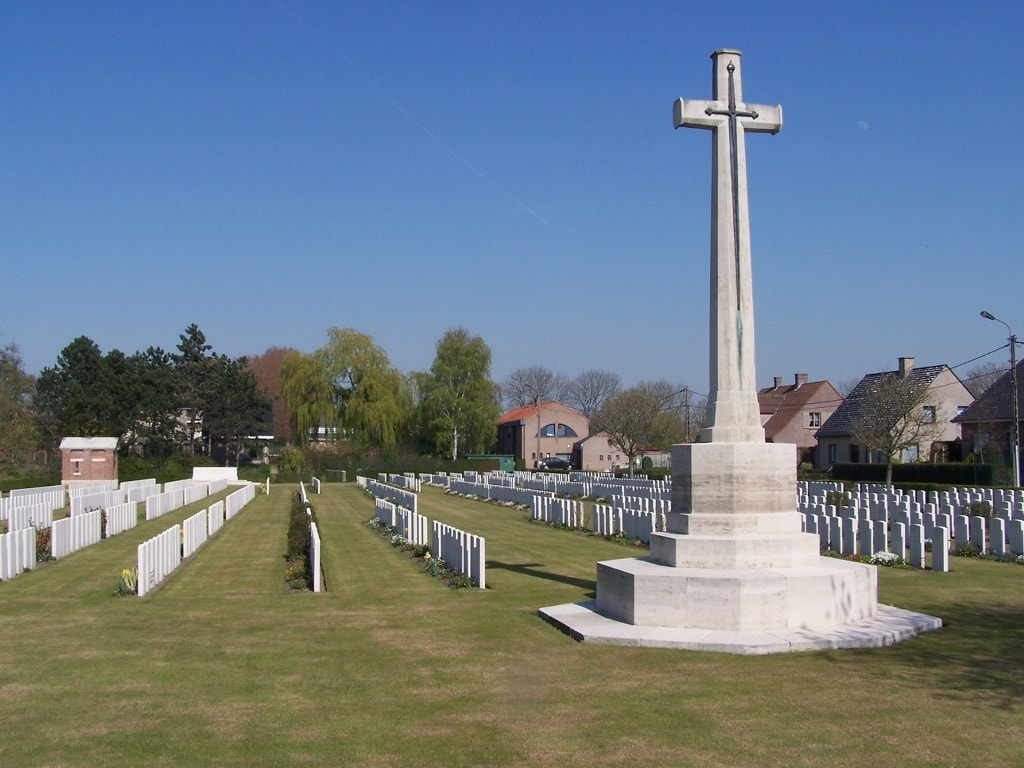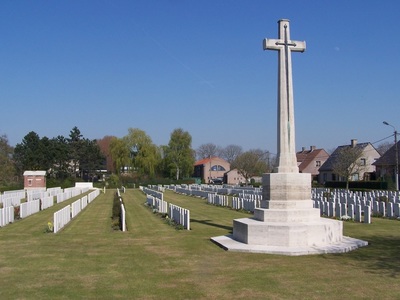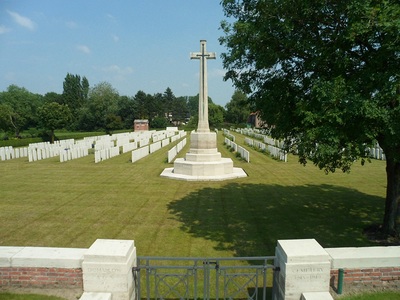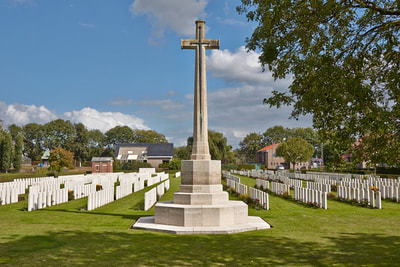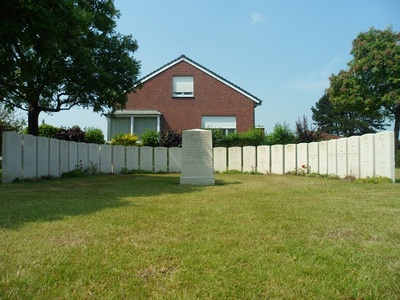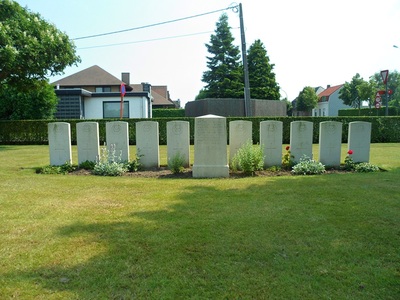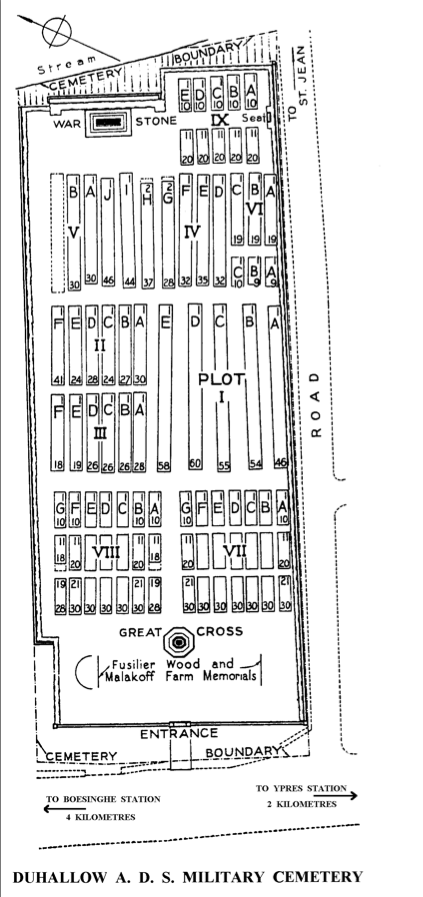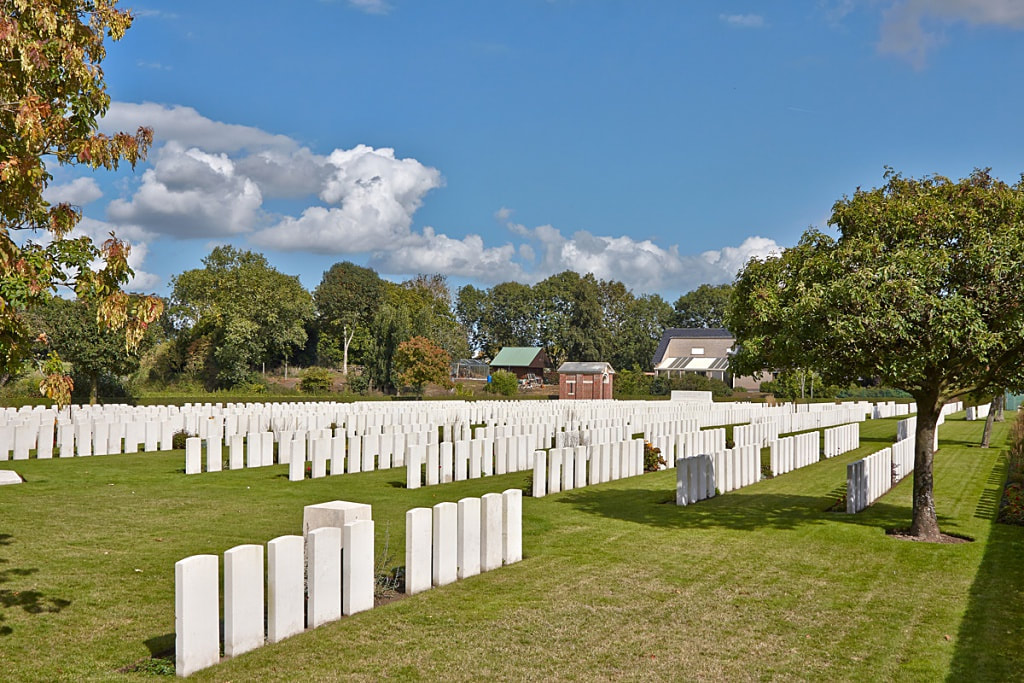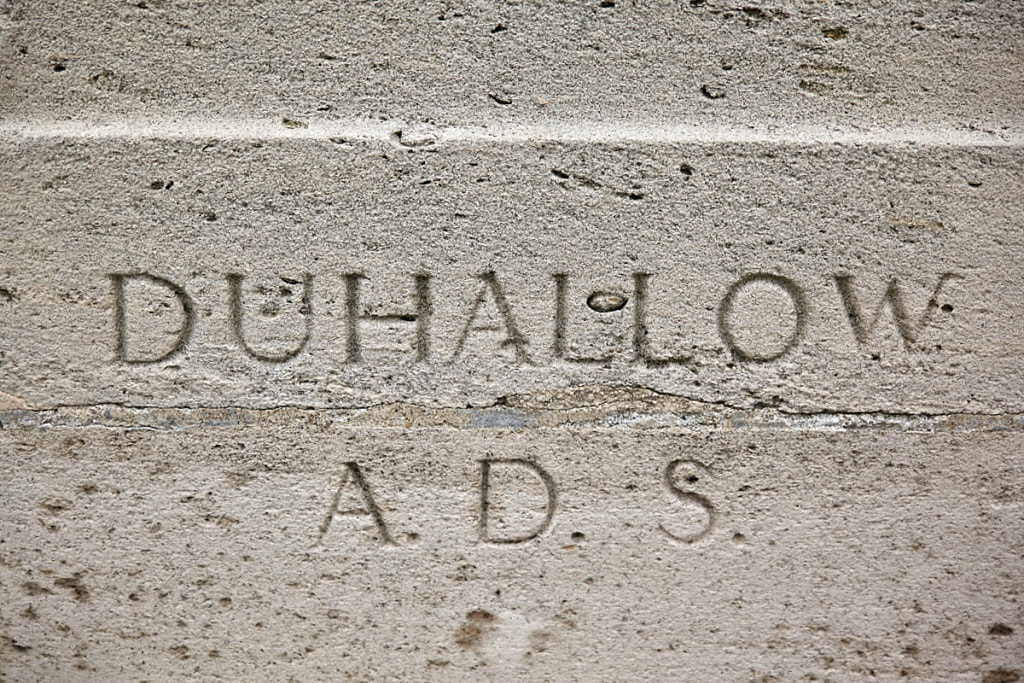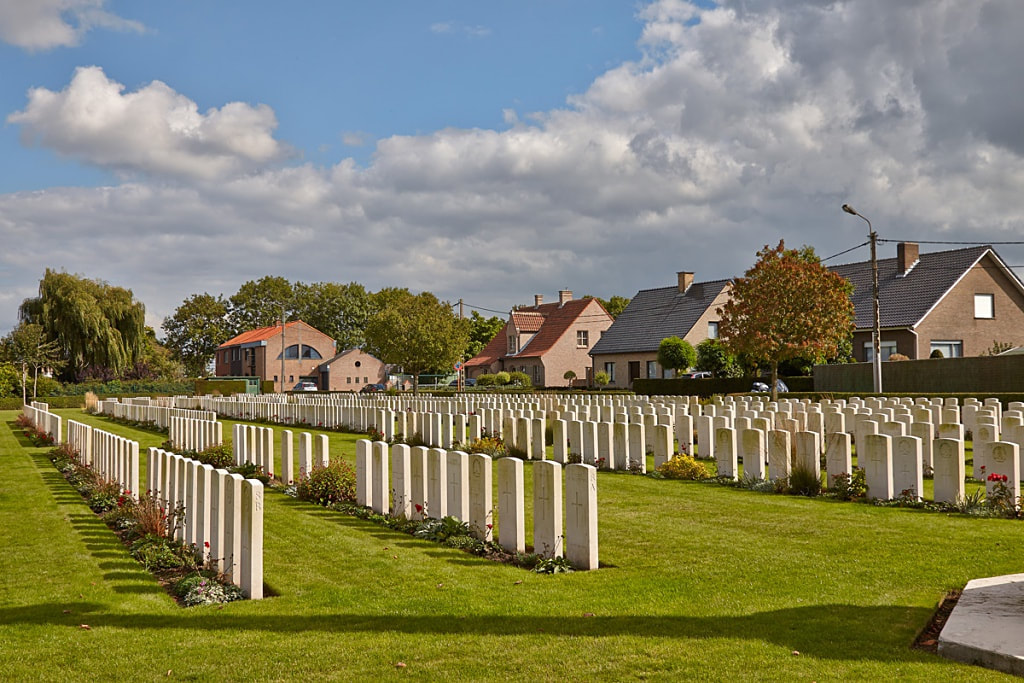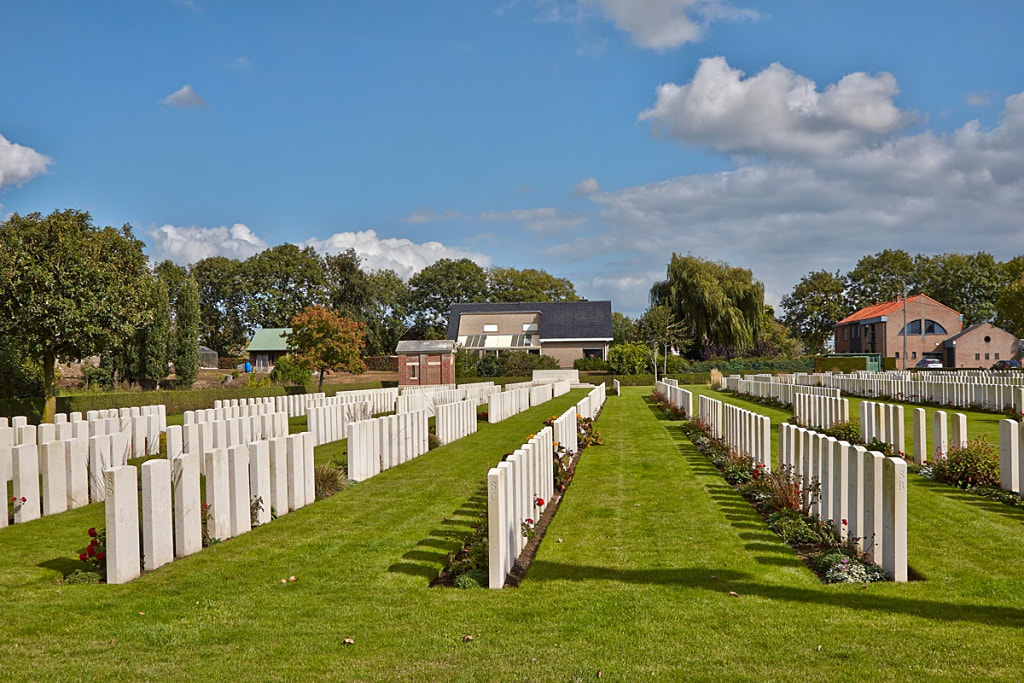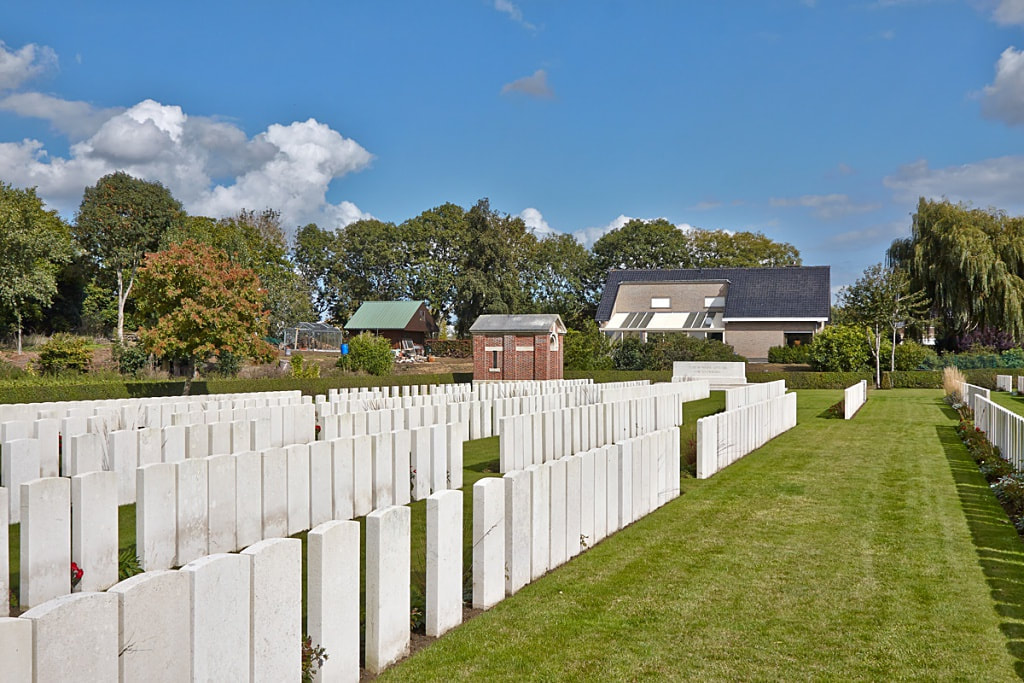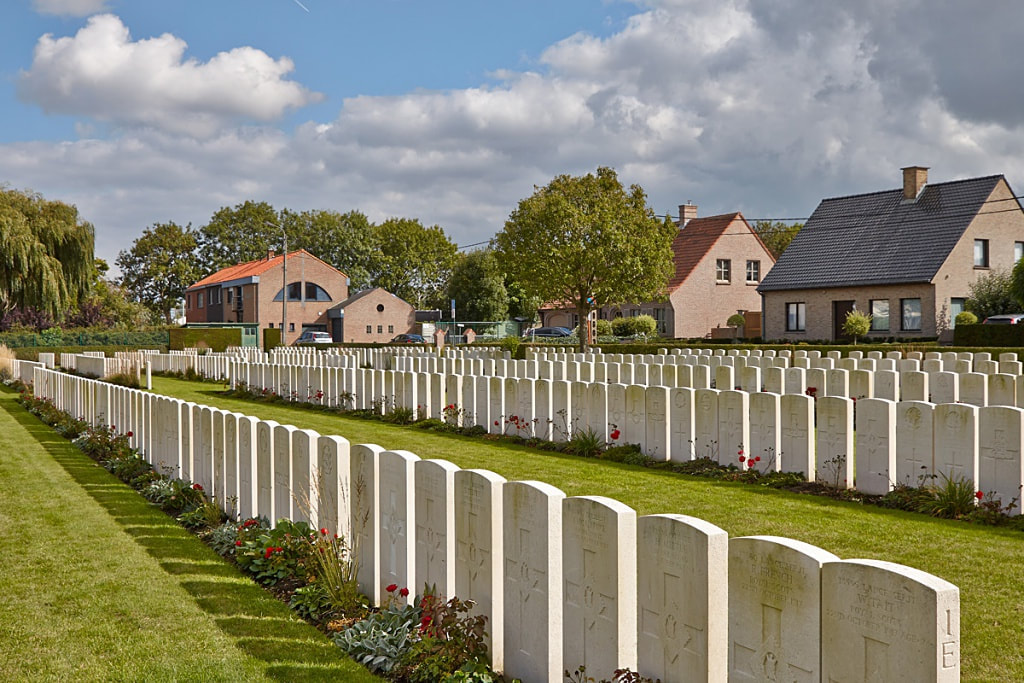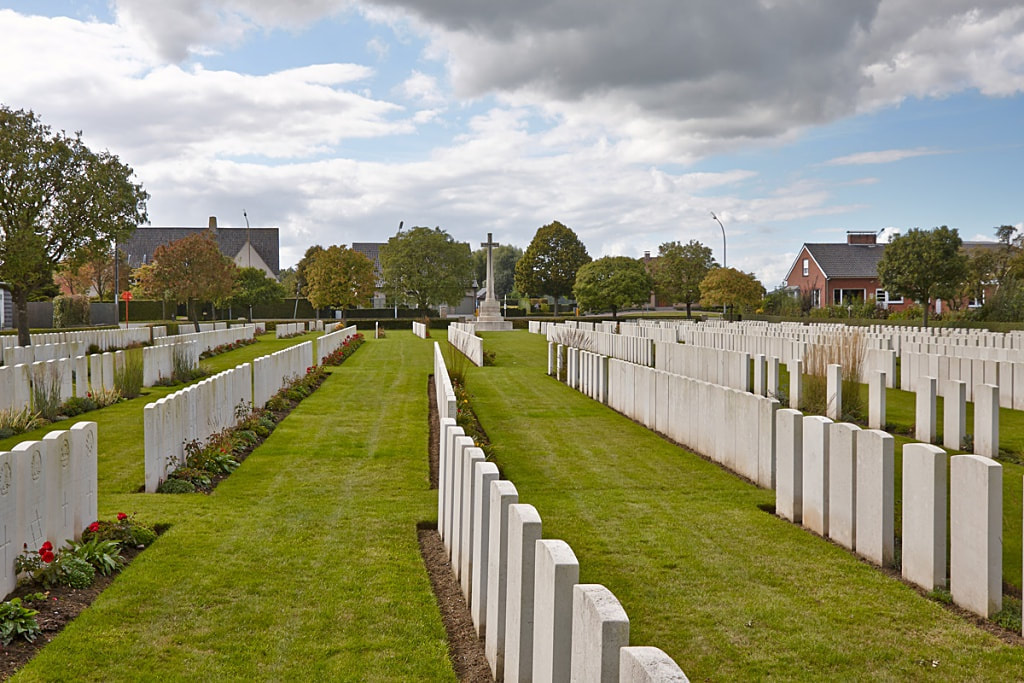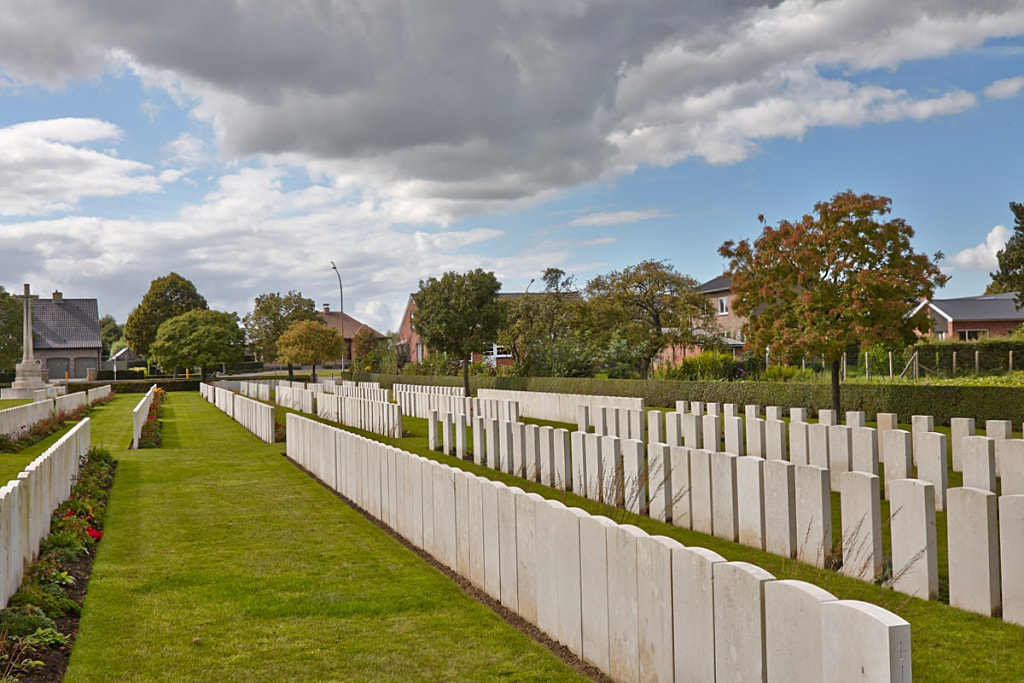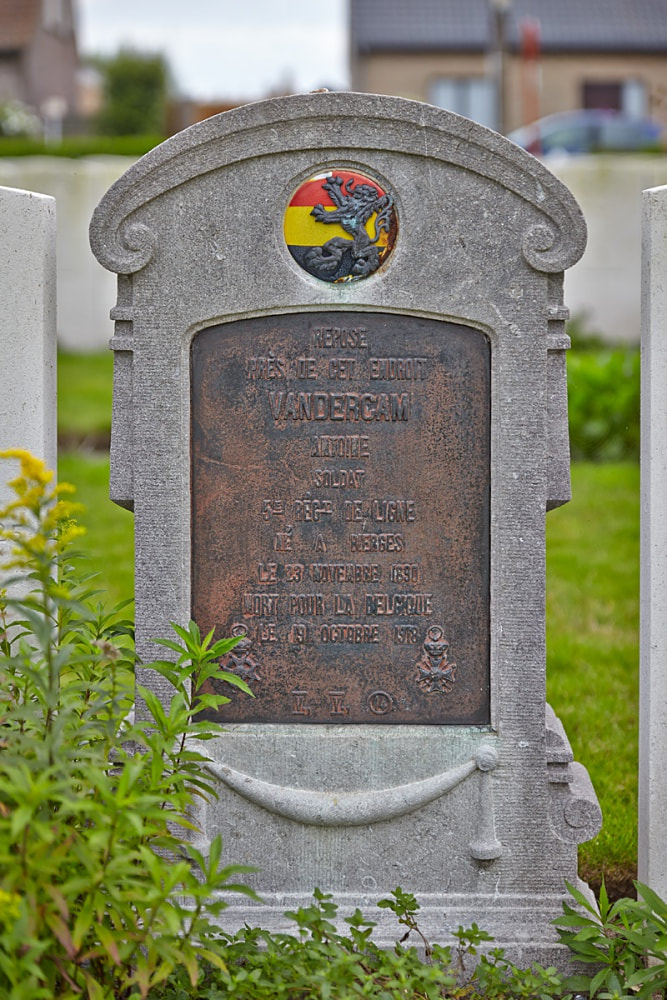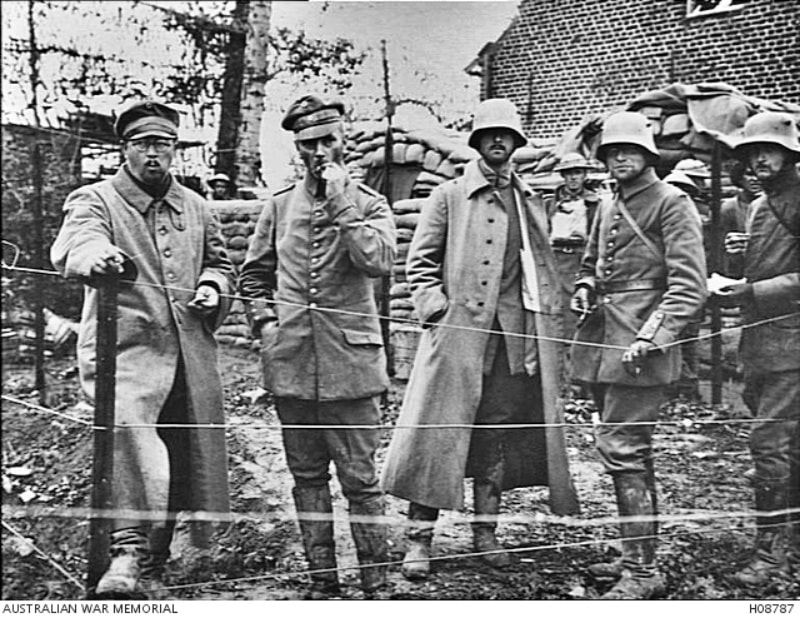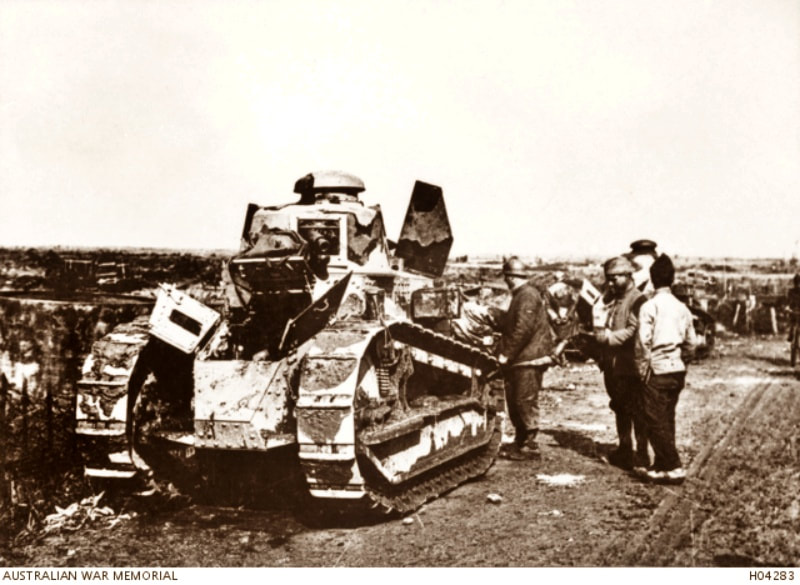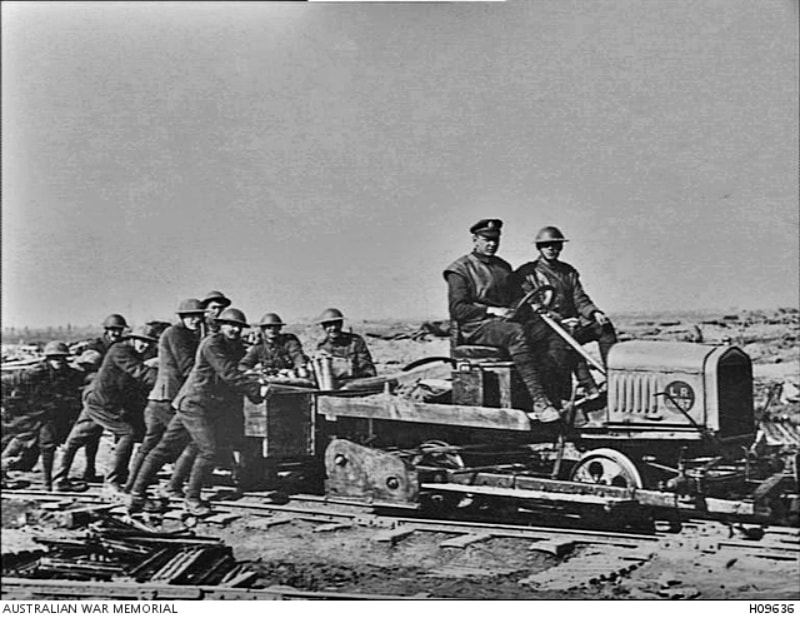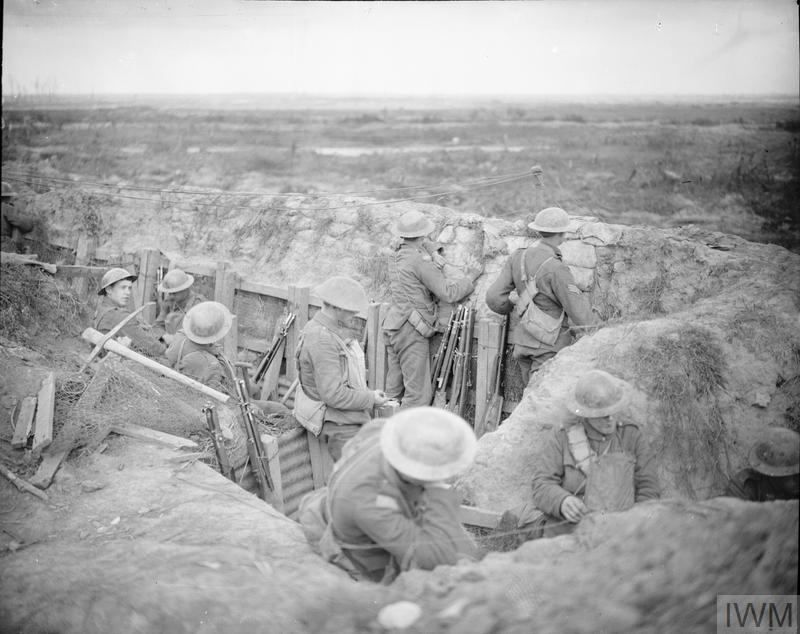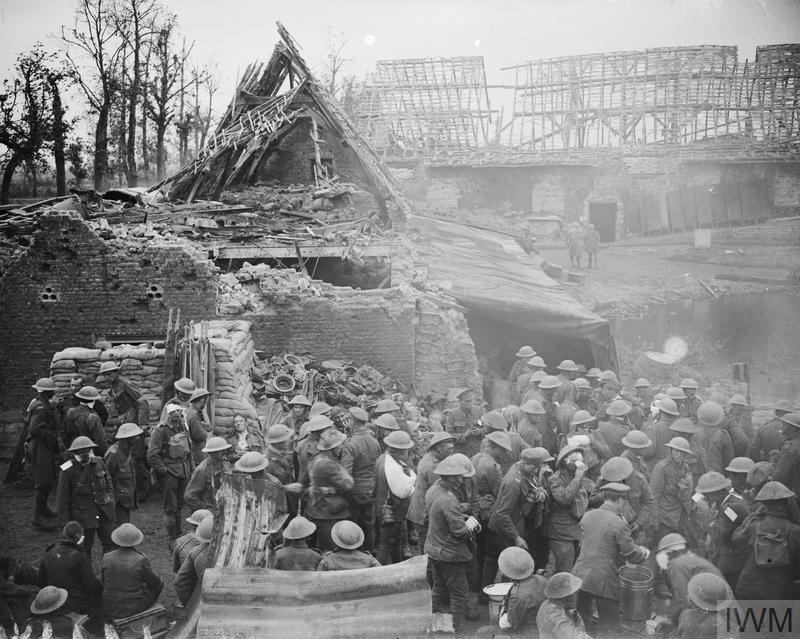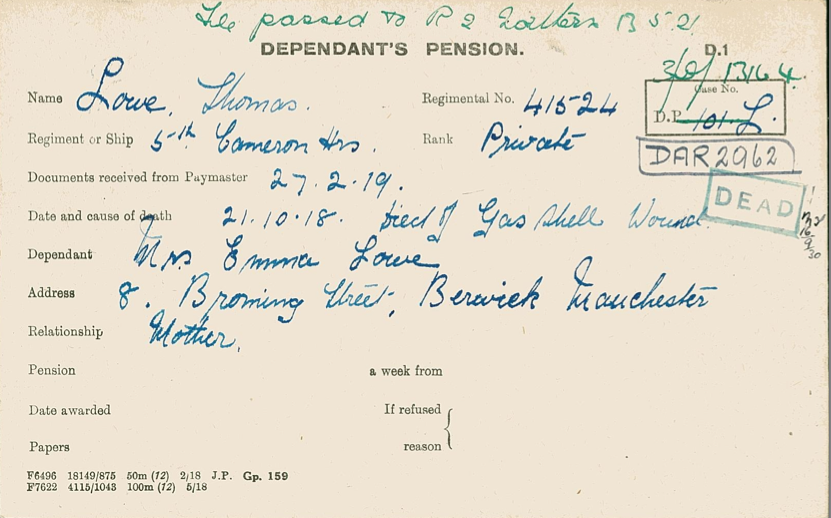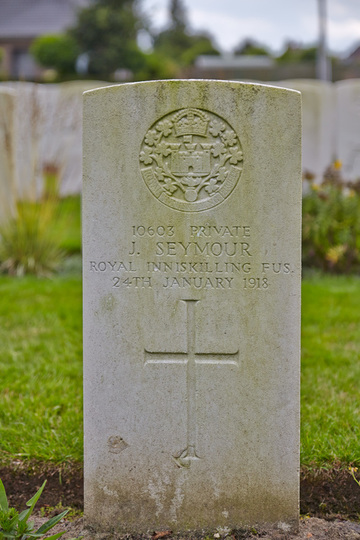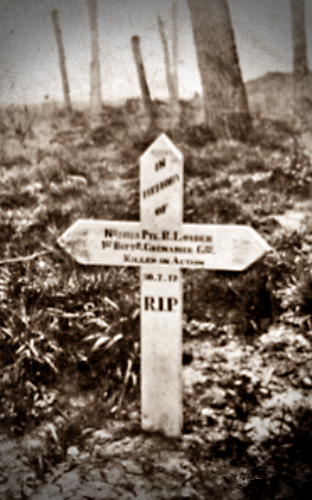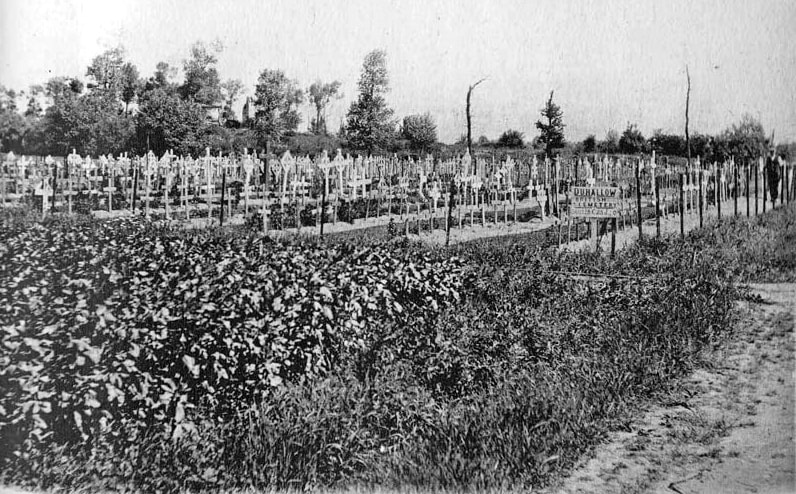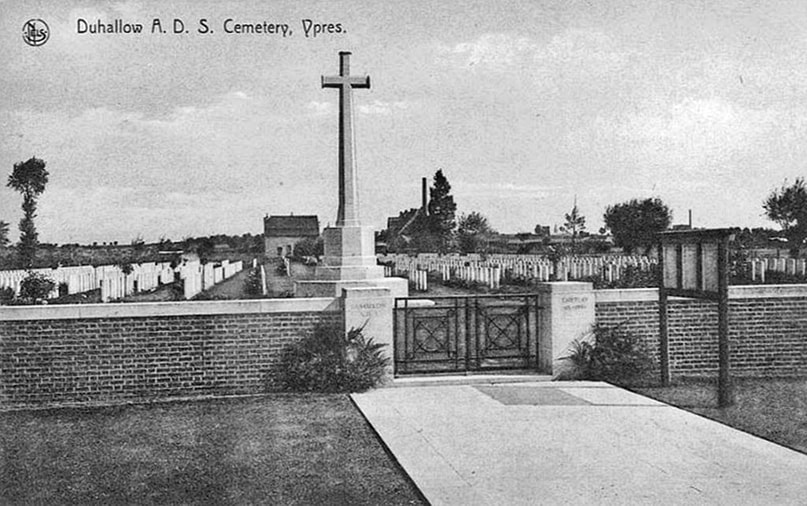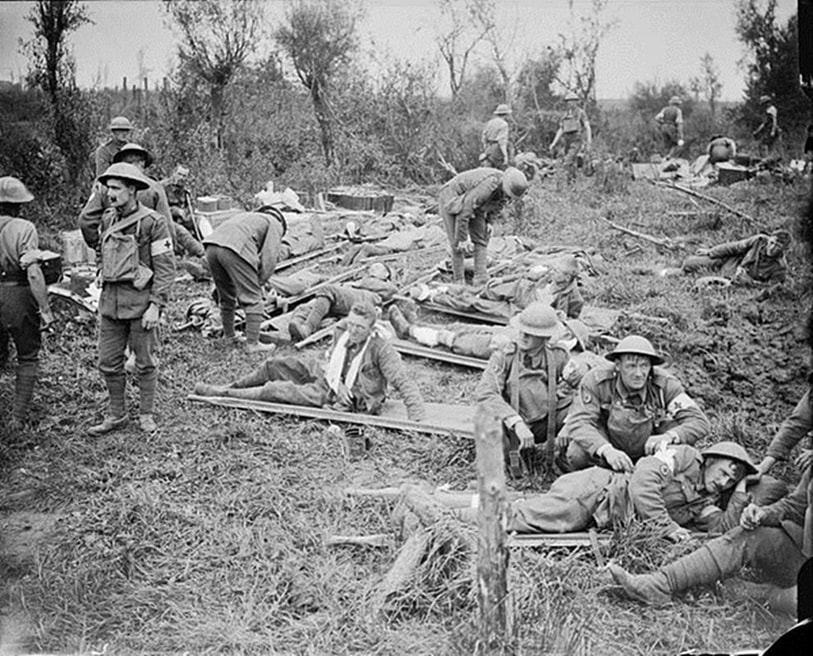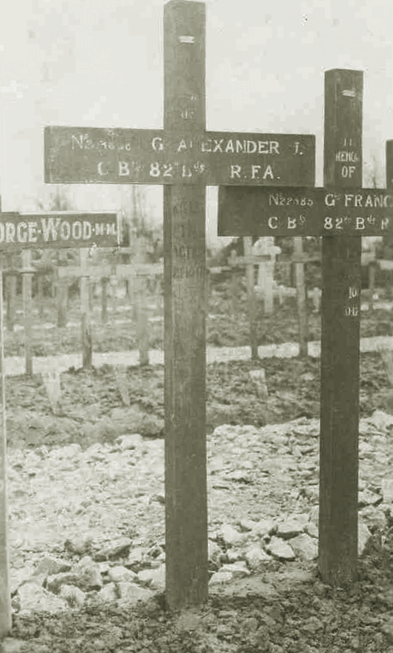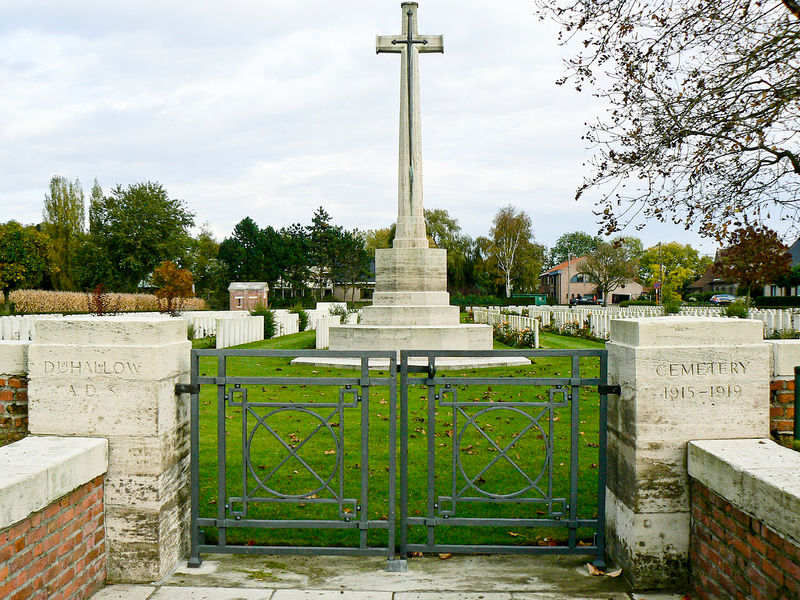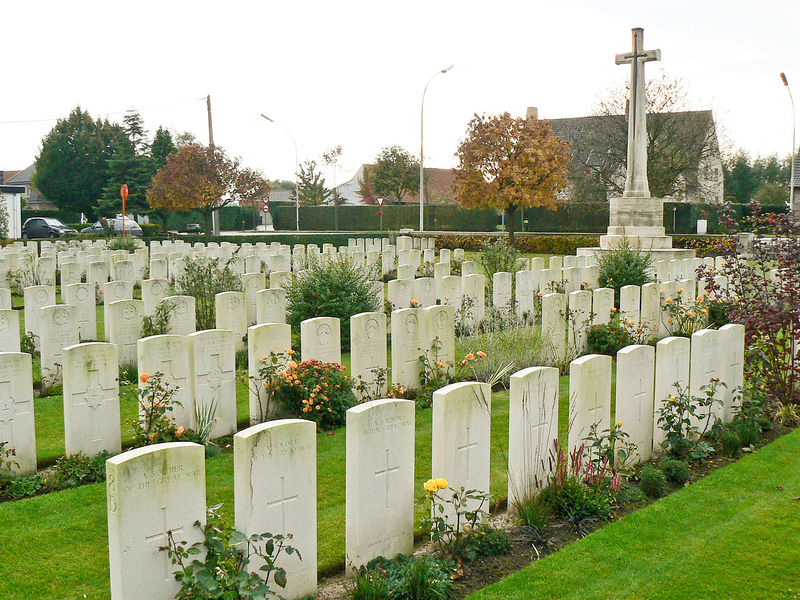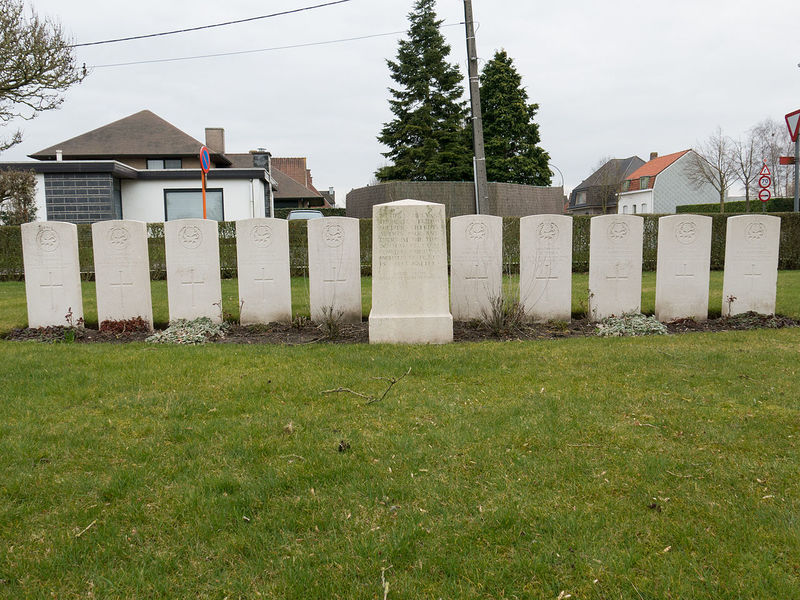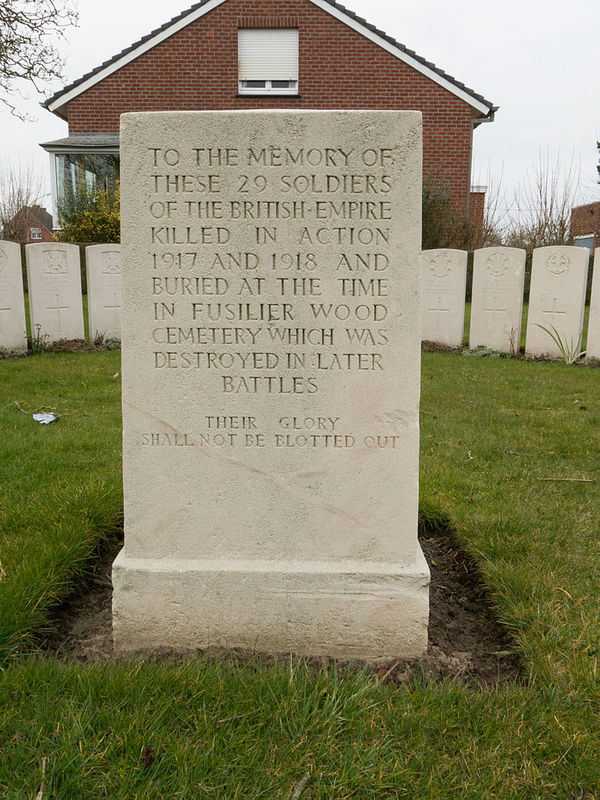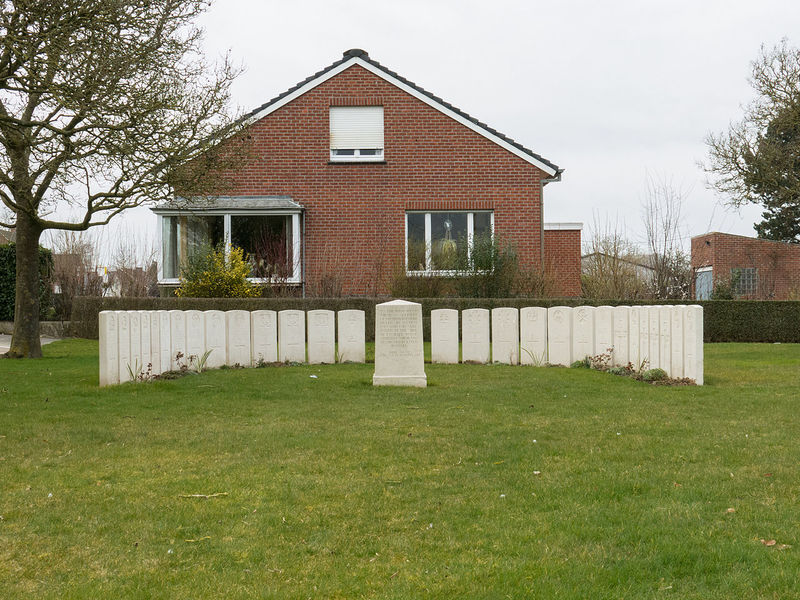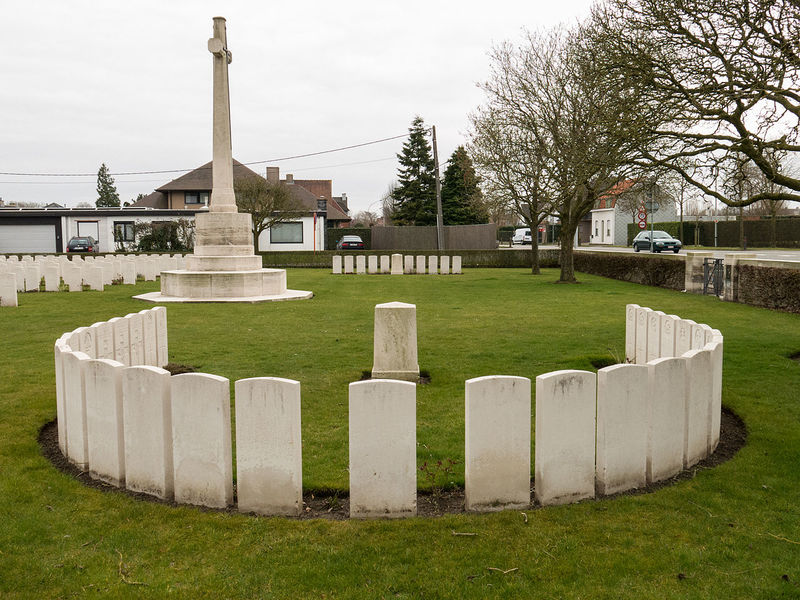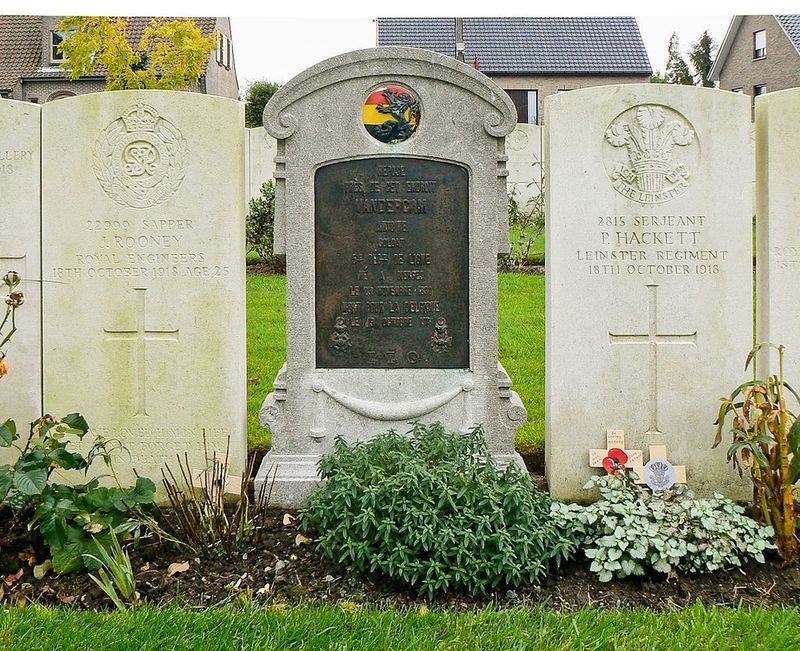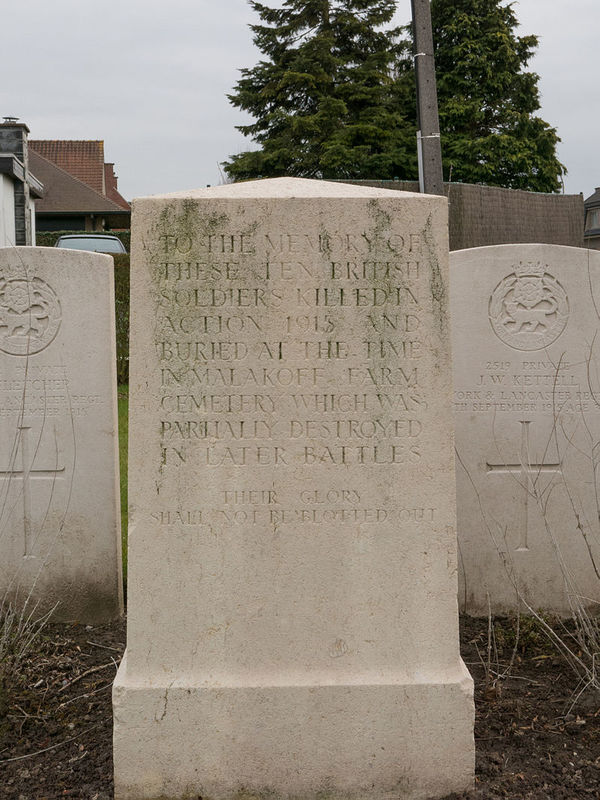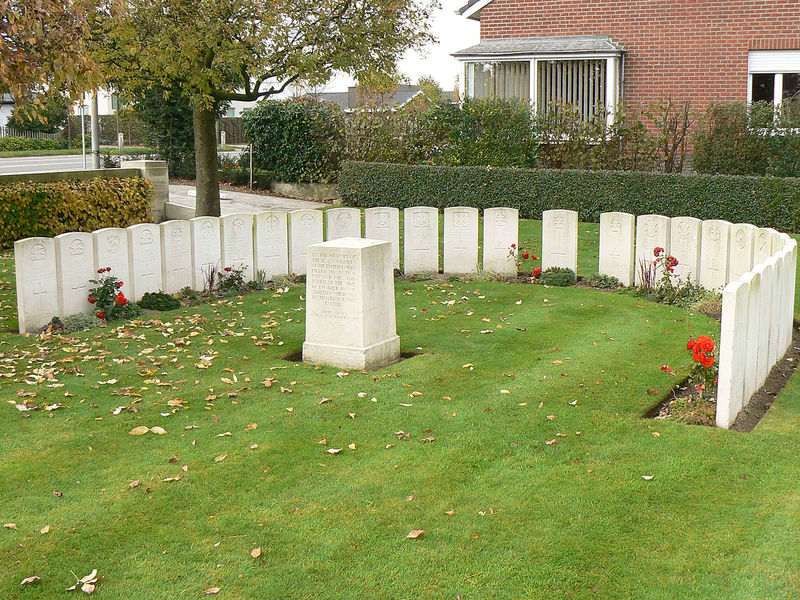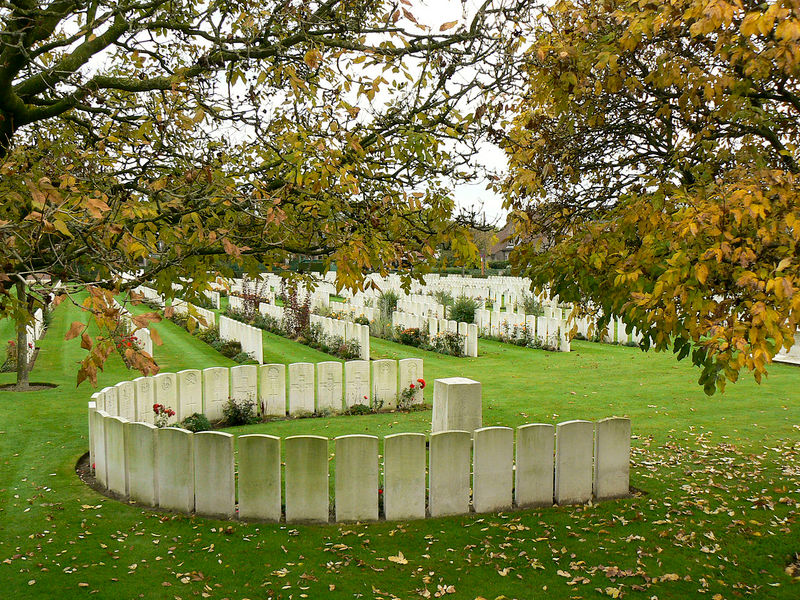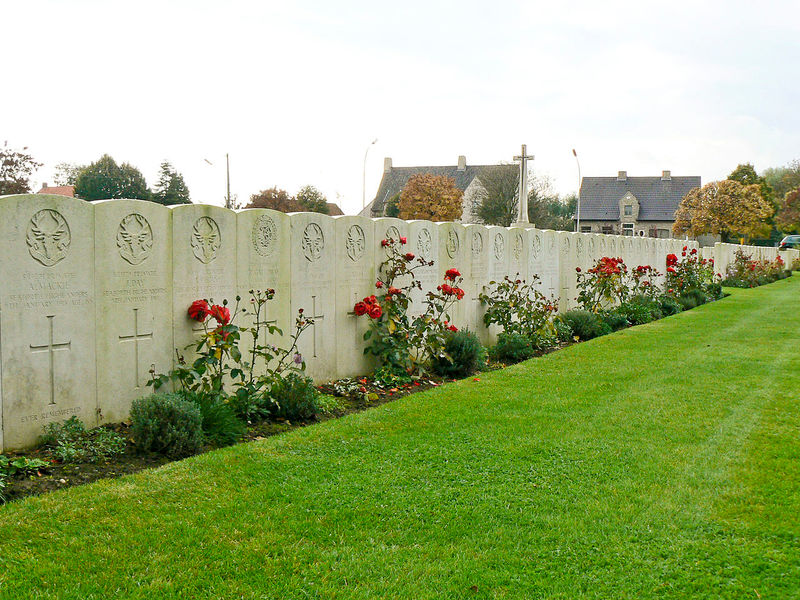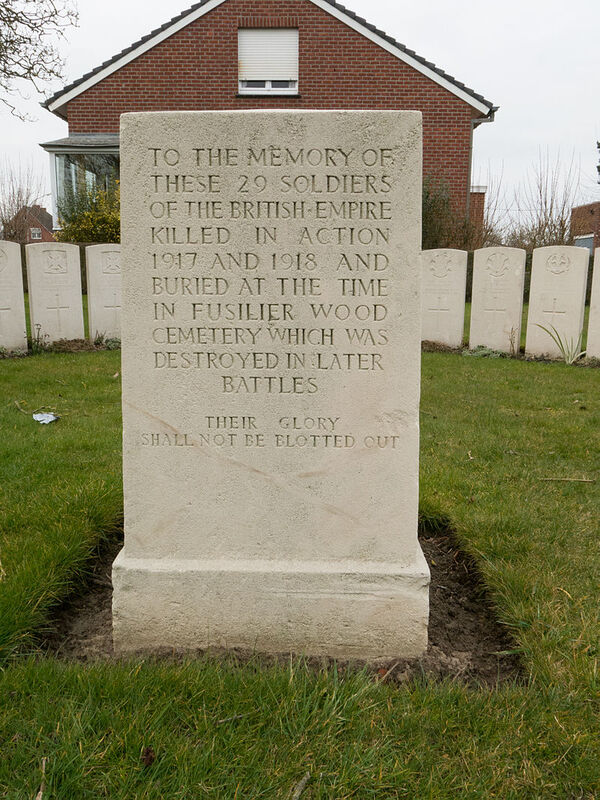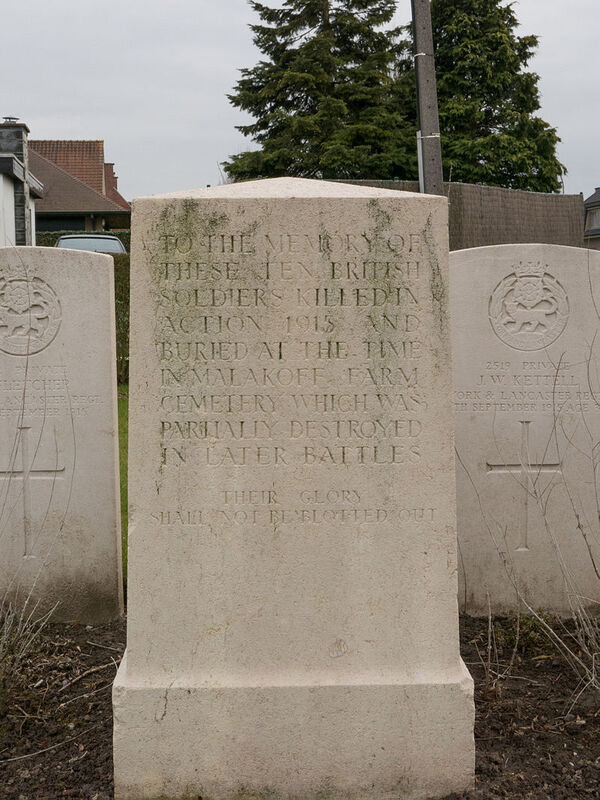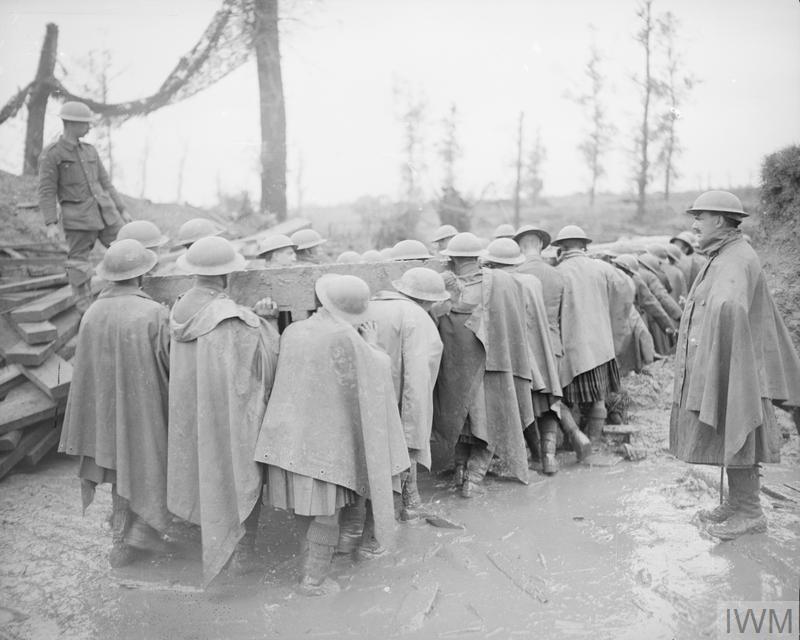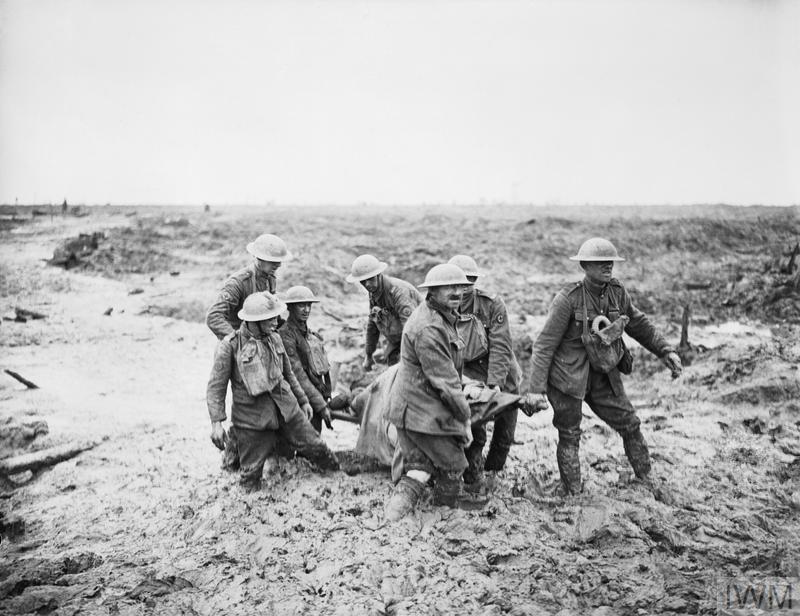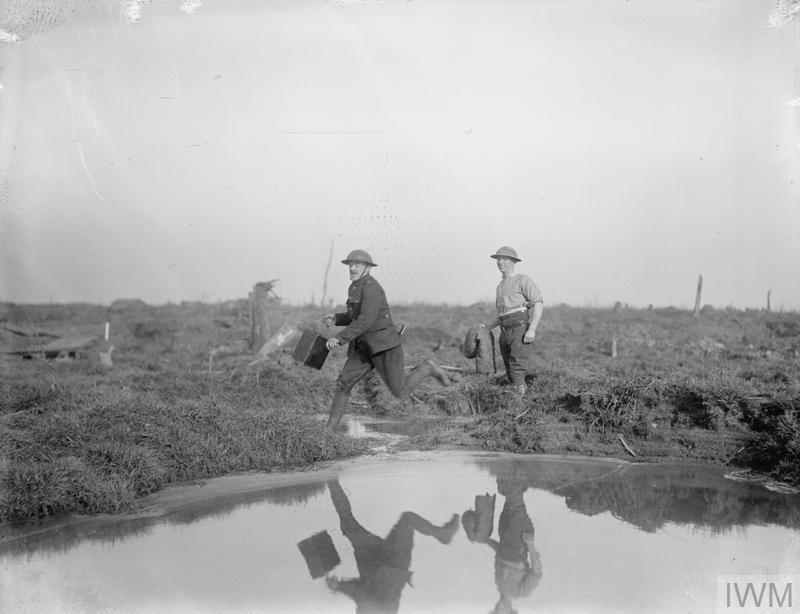DUHALLOW A. D. S. CEMETERY
West-Vlaanderen
Belgium
GPS Coordinates Latitude: 50.86395 Longitude: 2.87709
Location Information
The Cemetery is located on the Diksmuidseweg, N369 road, in the direction of Boezinge.
From Ieper station turn left into M.Fochlaan and go to the roundabout, turn right and go to the next roundabout. Here turn left and drive to the next roundabout, where you should turn right into Oude Veurnestraat. Take the second turning on the left which is the Diksmuidseweg. The cemetery is on the right hand side of the road just past the first turning on the right.
Visiting Information
Wheelchair access to site possible, but may be by an alternative entrance.
Historical Information
Duhallow Advanced Dressing Station, believed to have been named after a southern Irish hunt, was a medical post 1.6 kilometres north of Ypres (now Ieper). The cemetery was begun in July 1917 and in October and November 1918, it was used by the 11th, 36th and 44th Casualty Clearing Stations.
The cemetery contains many graves of the artillery and engineers and 41 men of the 13th Company Labour Corps, killed when a German aircraft dropped a bomb on an ammunition truck in January 1918, are buried in Plot II.
After the Armistice, the cemetery was enlarged when graves were brought into this cemetery from isolated sites and a number of small cemeteries on the battlefields around Ypres. Special memorials commemorate a number of casualties known to have been buried in two of these cemeteries, Malakoff Farm Cemetery, Brielen and Fusilier Wood Cemetery, Hollebeke, whose graves were destroyed by shellfire.
There are now 1,544 Commonwealth casualties of the First World War buried or commemorated in this cemetery, 231 of the burials unidentified. There are also 57 war graves of other nationalities, mostly German, and one Commonwealth burial of the Second World War, which dates from the Allied withdrawal ahead of the German advance of May 1940.
The cemetery was designed by Sir Reginald Blomfield and Noel Ackroyd Rew
Total Burials: 1,602
World War One Identified Casualties: United Kingdom 1,252. Germany 51, Canada 38, Australia 13, New Zealand 6, South Africa 3, Belgium 1, India 1. Total 1,365.
World War Two Identified Casualty: United Kingdom 1. Total 1.
The Cemetery is located on the Diksmuidseweg, N369 road, in the direction of Boezinge.
From Ieper station turn left into M.Fochlaan and go to the roundabout, turn right and go to the next roundabout. Here turn left and drive to the next roundabout, where you should turn right into Oude Veurnestraat. Take the second turning on the left which is the Diksmuidseweg. The cemetery is on the right hand side of the road just past the first turning on the right.
Visiting Information
Wheelchair access to site possible, but may be by an alternative entrance.
Historical Information
Duhallow Advanced Dressing Station, believed to have been named after a southern Irish hunt, was a medical post 1.6 kilometres north of Ypres (now Ieper). The cemetery was begun in July 1917 and in October and November 1918, it was used by the 11th, 36th and 44th Casualty Clearing Stations.
The cemetery contains many graves of the artillery and engineers and 41 men of the 13th Company Labour Corps, killed when a German aircraft dropped a bomb on an ammunition truck in January 1918, are buried in Plot II.
After the Armistice, the cemetery was enlarged when graves were brought into this cemetery from isolated sites and a number of small cemeteries on the battlefields around Ypres. Special memorials commemorate a number of casualties known to have been buried in two of these cemeteries, Malakoff Farm Cemetery, Brielen and Fusilier Wood Cemetery, Hollebeke, whose graves were destroyed by shellfire.
There are now 1,544 Commonwealth casualties of the First World War buried or commemorated in this cemetery, 231 of the burials unidentified. There are also 57 war graves of other nationalities, mostly German, and one Commonwealth burial of the Second World War, which dates from the Allied withdrawal ahead of the German advance of May 1940.
The cemetery was designed by Sir Reginald Blomfield and Noel Ackroyd Rew
Total Burials: 1,602
World War One Identified Casualties: United Kingdom 1,252. Germany 51, Canada 38, Australia 13, New Zealand 6, South Africa 3, Belgium 1, India 1. Total 1,365.
World War Two Identified Casualty: United Kingdom 1. Total 1.
Images in this gallery © Geerhard Joos
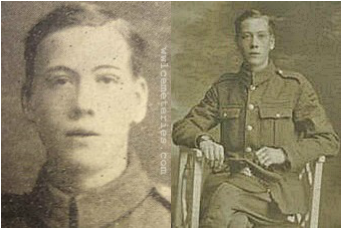
35736 Private
Harold Victor Atkinson, M. M.
15th Bn. Lancashire Fusiliers
25th December 1917, aged 20.
Plot II. E. 7.
Son of Ernest and Florence Atkinson, of 18, Mansergh St., Burnley, Lancs. Native of Manchester. Brother to Roy and Herbert who both survived.
Military Medal Citation - in the book 'The Lancashire Fusiliers' Pg. 277 "Much individual good work had contributed to the battalion's achievement. The Military Medal was awarded to 2 runners, Privates H. V. Atkinson & G. Beardsall, for gallantry in carrying messages throughout operations."
The London Gazette, 13th March 1918. Issue number: 30573 Page: 322.
Description: His Majesty the King has been graciously pleased to approve of the award of the Military Medal for bravery in the Field to the under mentioned Non-commissioned Officers and Men:- 35736, Pte. H. V. Atkinson, Lanc. Fus. (Burnley).
Picture courtesy of great niece, Alison Ford
Harold Victor Atkinson, M. M.
15th Bn. Lancashire Fusiliers
25th December 1917, aged 20.
Plot II. E. 7.
Son of Ernest and Florence Atkinson, of 18, Mansergh St., Burnley, Lancs. Native of Manchester. Brother to Roy and Herbert who both survived.
Military Medal Citation - in the book 'The Lancashire Fusiliers' Pg. 277 "Much individual good work had contributed to the battalion's achievement. The Military Medal was awarded to 2 runners, Privates H. V. Atkinson & G. Beardsall, for gallantry in carrying messages throughout operations."
The London Gazette, 13th March 1918. Issue number: 30573 Page: 322.
Description: His Majesty the King has been graciously pleased to approve of the award of the Military Medal for bravery in the Field to the under mentioned Non-commissioned Officers and Men:- 35736, Pte. H. V. Atkinson, Lanc. Fus. (Burnley).
Picture courtesy of great niece, Alison Ford
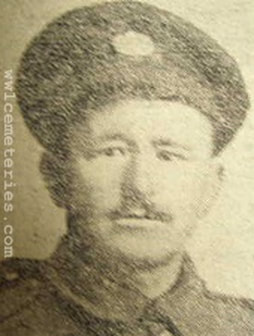
117433 Pioneer
William Buckley
4th Army Tramway Coy. Royal Engineers
16th February 1918, aged 38.
Plot III. F. 18.
Husband of Lydia A. Gibson (formerly Buckley), of 13, Back Baker St., Burnley, Lancs. Before re-marrying she lived with William at 100 Piccadilly Road, Burnley. In civilian life he worked for Schofield's Slaters in Burnley,
William Buckley
4th Army Tramway Coy. Royal Engineers
16th February 1918, aged 38.
Plot III. F. 18.
Husband of Lydia A. Gibson (formerly Buckley), of 13, Back Baker St., Burnley, Lancs. Before re-marrying she lived with William at 100 Piccadilly Road, Burnley. In civilian life he worked for Schofield's Slaters in Burnley,
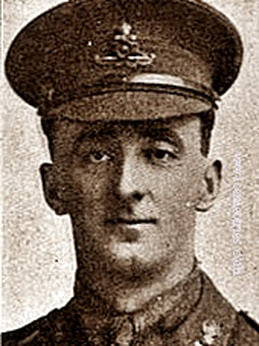
24965 Second Lieutenant
William Chirnside
New Zealand Field Artillery
11th October 1917, aged 36.
Plot I. D. 40.
Son of Robert and Margaret Chirnside, of Wellington, New Zealand; husband of Hannah Lewis Chirnside, of 61, Matai Rd., Hataitai, Wellington, New Zealand. Served in the South African War.
William Chirnside
New Zealand Field Artillery
11th October 1917, aged 36.
Plot I. D. 40.
Son of Robert and Margaret Chirnside, of Wellington, New Zealand; husband of Hannah Lewis Chirnside, of 61, Matai Rd., Hataitai, Wellington, New Zealand. Served in the South African War.
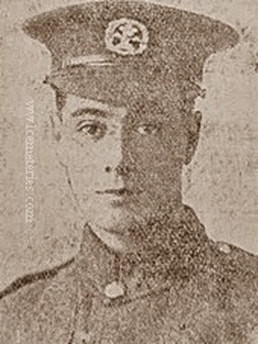
39492 Private
Sidney Collins
7th Bn. South Lancashire Regiment
20th September 1917, aged 19.
Fusilier Wood Memorial
Son of Mrs. M. E. Collins, of 3, Acacia Grove, West Kirby, Cheshire, and the late Mr. Collins.
Sidney Collins
7th Bn. South Lancashire Regiment
20th September 1917, aged 19.
Fusilier Wood Memorial
Son of Mrs. M. E. Collins, of 3, Acacia Grove, West Kirby, Cheshire, and the late Mr. Collins.
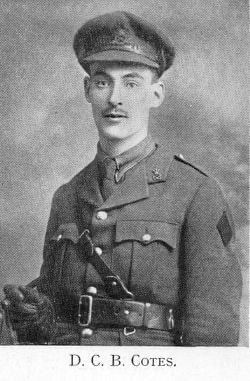
Captain
Digby Charles Bathe Cotes
7th Bn. attached to 4th Bn. North Staffordshire Regiment
15th October 1918, aged 25.
Plot IV. G. 13.
Son of Digby Francis Baynes Cotes and Alice Mabel Cotes, of Burton-on-Trent. Served from 1st Sept., 1914 in Gallipoli and France.
His headstone bears the inscription "Blessed Are The Pure In Heart For They Shall See God"
The information below supplied by 'The Ellesmerian Club', the alumni organisation for Ellesmere College where Digby was a pupil.
Digby Charles Bathe Cotes
7th Bn. attached to 4th Bn. North Staffordshire Regiment
15th October 1918, aged 25.
Plot IV. G. 13.
Son of Digby Francis Baynes Cotes and Alice Mabel Cotes, of Burton-on-Trent. Served from 1st Sept., 1914 in Gallipoli and France.
His headstone bears the inscription "Blessed Are The Pure In Heart For They Shall See God"
The information below supplied by 'The Ellesmerian Club', the alumni organisation for Ellesmere College where Digby was a pupil.
Digby Charles Bathe Cotes, the only son of Digby and Alice Cotes, was born in Teddington on 18th November 1892. Sadly, his mother died in 1901 when he was just nine years old. His early education was at the Latin School, Buckinghamshire where he seemed to excel – in 1906 he was to pass his Preliminary Oxford Local Examinations in the First Division.
His father was a surgeon and it appears the family moved to Burton-on-Trent sometime after 1906. It was in September 1909 that Digby arrived at Ellesmere College to take up his place in the ‘Gordon’ dormitory at a time when there were approximately one hundred and sixty pupils on the nominal roll.
Digby enjoyed a full and active part in college life until he left in July 1912. On the sports field, he played cricket and hockey for his dormitory and he seemed to excel on the athletics track – on Sports Day of 1911 he took first place in the 220 yards race.
On the academic side of life, he was awarded the VIth Form Maths prize for three consecutive years and, in 1911, not only did he win the VIth Form English Prize and the ‘Open essay’ Prize but he was also awarded the first prize in a national essay writing competition which had been organised amongst all the secondary schools in England. In November 1910, he was entered to take his Senior Oxford Local examinations – we know he passed but have no details in which subjects.
Digby was an enthusiastic member of the Debating Society, eventually being appointed to the role of Secretary. He was heavily involved in the running of a ‘mock election’ and went on to edit The Ellesmerian for several editions but still found time to ‘tread the boards’ in the 1910 and 1911 Shakespearian Society Productions of “Love’s Labours Lost’ and “King John”. He was appointed Prefect in November 1911.
On leaving Ellesmere, he moved to Sherbourne House School, Haverstock Hill, London as an Assistant Master for a short time before going to Trinity College, Dublin where he matriculated.
He enlisted on 8th August 1914, three days after war was declared, although his original intentions had been to join the church. He was gazetted to the North Staffordshire Regiment on 1st September. He served with the 7thBattalion at Gallipoli and was severely wounded on 8th August 1915 in an operation that claimed the life of one Officer and saw 85 Other Ranks killed, wounded or missing.
He was afterwards attached to the 2/6th Battalion, the North Staffordshire Regiment, with whom he served in France for ten months, returning to England on sick leave in March 1918. On his return to the Front, having been appointed to the rank of Captain, Digby was attached to another battalion of the North Staffordshires that was short of officers and died of gunshot wounds on 15th October 1918. He was just twenty-five years old. For his military service he was awarded the Victory Medal, the British War Medal and the 1914-1915 Star
He was buried in the Duhallow A.D.S. Cemetery, Belgium and his memory is commemorated on the Memorial at the entrance to the 1937 Reading Room at Trinity College, Dublin University and on the Memorial at Ellesmere College.
He is further remembered in the Ellesmere College ‘Roll of Honour’ and in the volume ’Ireland, Casualties of World War I’.
His father was a surgeon and it appears the family moved to Burton-on-Trent sometime after 1906. It was in September 1909 that Digby arrived at Ellesmere College to take up his place in the ‘Gordon’ dormitory at a time when there were approximately one hundred and sixty pupils on the nominal roll.
Digby enjoyed a full and active part in college life until he left in July 1912. On the sports field, he played cricket and hockey for his dormitory and he seemed to excel on the athletics track – on Sports Day of 1911 he took first place in the 220 yards race.
On the academic side of life, he was awarded the VIth Form Maths prize for three consecutive years and, in 1911, not only did he win the VIth Form English Prize and the ‘Open essay’ Prize but he was also awarded the first prize in a national essay writing competition which had been organised amongst all the secondary schools in England. In November 1910, he was entered to take his Senior Oxford Local examinations – we know he passed but have no details in which subjects.
Digby was an enthusiastic member of the Debating Society, eventually being appointed to the role of Secretary. He was heavily involved in the running of a ‘mock election’ and went on to edit The Ellesmerian for several editions but still found time to ‘tread the boards’ in the 1910 and 1911 Shakespearian Society Productions of “Love’s Labours Lost’ and “King John”. He was appointed Prefect in November 1911.
On leaving Ellesmere, he moved to Sherbourne House School, Haverstock Hill, London as an Assistant Master for a short time before going to Trinity College, Dublin where he matriculated.
He enlisted on 8th August 1914, three days after war was declared, although his original intentions had been to join the church. He was gazetted to the North Staffordshire Regiment on 1st September. He served with the 7thBattalion at Gallipoli and was severely wounded on 8th August 1915 in an operation that claimed the life of one Officer and saw 85 Other Ranks killed, wounded or missing.
He was afterwards attached to the 2/6th Battalion, the North Staffordshire Regiment, with whom he served in France for ten months, returning to England on sick leave in March 1918. On his return to the Front, having been appointed to the rank of Captain, Digby was attached to another battalion of the North Staffordshires that was short of officers and died of gunshot wounds on 15th October 1918. He was just twenty-five years old. For his military service he was awarded the Victory Medal, the British War Medal and the 1914-1915 Star
He was buried in the Duhallow A.D.S. Cemetery, Belgium and his memory is commemorated on the Memorial at the entrance to the 1937 Reading Room at Trinity College, Dublin University and on the Memorial at Ellesmere College.
He is further remembered in the Ellesmere College ‘Roll of Honour’ and in the volume ’Ireland, Casualties of World War I’.
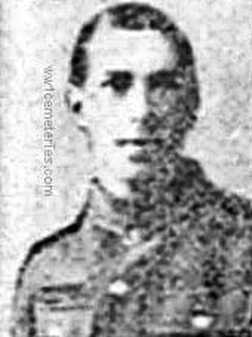
24019 Private
Thomas George Dixon
9th Bn. Royal Irish Fusiliers
30th September 1918, aged 20.
Plot IX. E. 9.
Son of William and Mary J. Dixon. of 67, Delhi St., Belfast.
Thomas George Dixon
9th Bn. Royal Irish Fusiliers
30th September 1918, aged 20.
Plot IX. E. 9.
Son of William and Mary J. Dixon. of 67, Delhi St., Belfast.
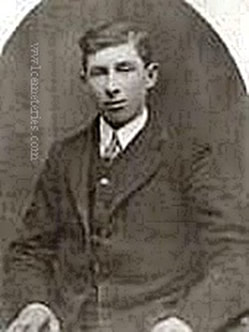
28199 Private
William John Grant
7th Bn. King's Own (Royal Lancaster Regiment)
23rd September 1917, aged 19.
Fusilier Wood Memorial
Son of George Grant, of East Huntspill, Highbridge, Somerset.
William John Grant
7th Bn. King's Own (Royal Lancaster Regiment)
23rd September 1917, aged 19.
Fusilier Wood Memorial
Son of George Grant, of East Huntspill, Highbridge, Somerset.
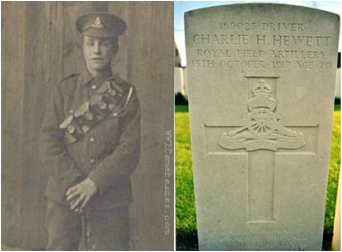
169023 Driver
Charles (Charlie) Hamond Hewett
84th Bde. Ammunition Column, Royal Field Artillery
15th October 1917, aged 20.
Plot I. E. 15.
Son of Hamond and Mary Ann Hewett, of 38, Milton Rd., Margate.
Pictures courtesy of great niece, Kay Norton
Charles (Charlie) Hamond Hewett
84th Bde. Ammunition Column, Royal Field Artillery
15th October 1917, aged 20.
Plot I. E. 15.
Son of Hamond and Mary Ann Hewett, of 38, Milton Rd., Margate.
Pictures courtesy of great niece, Kay Norton
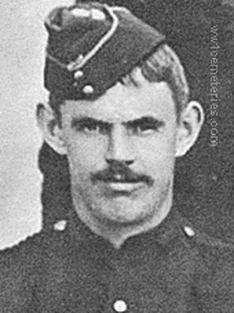
RMA/5828 Gunner
Archibald Boniface Silas Joyce
No. 6 Gun, Howitzer Bde. R.N. Div. Royal Marine Artillery
7th October 1917, aged 45.
Plot VII. F. 11.
Long Service and Good Conduct Medal. Son of John and Frances Joyce, of Rudgwick, Sussex; husband of Harriett Eleanor Joyce, of 44, Queen St., Horsham, Sussex.
Archibald Boniface Silas Joyce
No. 6 Gun, Howitzer Bde. R.N. Div. Royal Marine Artillery
7th October 1917, aged 45.
Plot VII. F. 11.
Long Service and Good Conduct Medal. Son of John and Frances Joyce, of Rudgwick, Sussex; husband of Harriett Eleanor Joyce, of 44, Queen St., Horsham, Sussex.
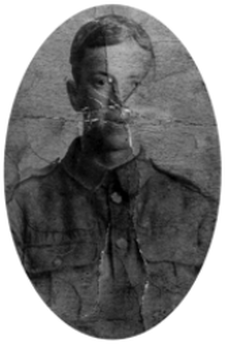
41524 Private
Thomas Lowe
5th Bn. Cameron Highlanders
21st October 1918, aged 22.
Plot IV. J. 33.
Born and enlisted in Manchester and on his enlistment he gave his residence as Beswick, Manchester.
Previously served as Private 20173, Platoon 3, "A" Company, 22nd Battalion, Manchester Regiment and Private D/17974, Yeomanry Cyclists. Thomas served overseas in 1918, with 5th Cameron Highlanders and his service with the other 2 units being training and home service.
His Father Matthew died in the war and is commemorated on the Thiepval Memorial on the Somme
Pictures and text courtesy of Matthew Lucas
Thomas Lowe
5th Bn. Cameron Highlanders
21st October 1918, aged 22.
Plot IV. J. 33.
Born and enlisted in Manchester and on his enlistment he gave his residence as Beswick, Manchester.
Previously served as Private 20173, Platoon 3, "A" Company, 22nd Battalion, Manchester Regiment and Private D/17974, Yeomanry Cyclists. Thomas served overseas in 1918, with 5th Cameron Highlanders and his service with the other 2 units being training and home service.
His Father Matthew died in the war and is commemorated on the Thiepval Memorial on the Somme
Pictures and text courtesy of Matthew Lucas
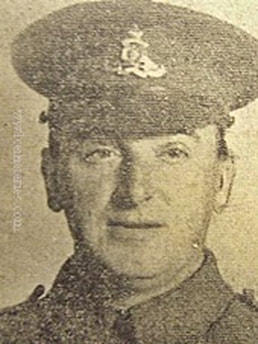
112545 Gunner
Walter Waller Marsden
212th Siege Bty. Royal Garrison Artillery
13th August 1917, aged 33.
Plot I. A. 5.
Son of William Waller & Jane Marsden. Lived at 15 West Street, Burnley.
Walter Waller Marsden
212th Siege Bty. Royal Garrison Artillery
13th August 1917, aged 33.
Plot I. A. 5.
Son of William Waller & Jane Marsden. Lived at 15 West Street, Burnley.
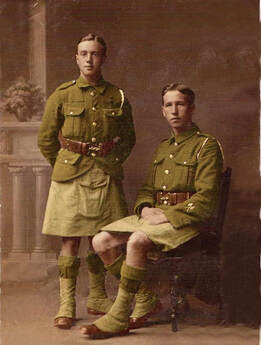
300219 Private
Neil Mason (Standing)
10th Bn. Argyll and Sutherland Highlanders
13th October 1917.
Plot I. D. 58.
Click on image to enlarge
Neil mason; born Campbeltown 1897; 1915 along with his brother Daniel Joined the Argyll & Sutherland Highlanders (under age), 1917 took part in the battle Passchendaele, Oct 1917 he was severely wounded and died of his wounds aged 19 on 10 Oct 1917.
His brother Daniel was also killed in the Great War and is buried in Athies Communal Cemetery Extension
The picture and text relating to Neil are courtesy of Iain Jamieson (Great Nephew). Iain also had another Great Uncle who died in the Great War, Adam Burrell who died on the 1st day of the Battle of the Somme and is buried in Ovillers Military Cemetery.
Neil Mason (Standing)
10th Bn. Argyll and Sutherland Highlanders
13th October 1917.
Plot I. D. 58.
Click on image to enlarge
Neil mason; born Campbeltown 1897; 1915 along with his brother Daniel Joined the Argyll & Sutherland Highlanders (under age), 1917 took part in the battle Passchendaele, Oct 1917 he was severely wounded and died of his wounds aged 19 on 10 Oct 1917.
His brother Daniel was also killed in the Great War and is buried in Athies Communal Cemetery Extension
The picture and text relating to Neil are courtesy of Iain Jamieson (Great Nephew). Iain also had another Great Uncle who died in the Great War, Adam Burrell who died on the 1st day of the Battle of the Somme and is buried in Ovillers Military Cemetery.
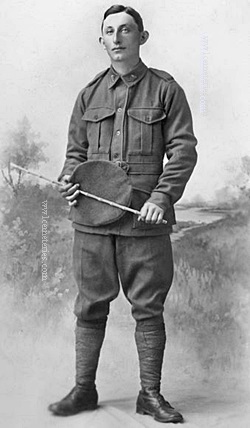
5433 Private
Edward Pizer
14th Bn. Australian Infantry, A. I. F.
28th September 1917, aged 22.
Plot IX. C. 18.
Son of Samuel and Millie Pizer, of Lovilla, Pakington St., Geelong, Victoria, Australia. Born London, England.
A native of London, England, Pte Pizer was a tailor from Geelong, Vic prior to enlistment and embarked with the 17th Reinforcements from Melbourne on HMAT Euripides on 4 April 1916. On 28 September 1917 he was killed in action, aged 23, and was buried near Molenaarelsthoek SE of Zonnebeke, Belgium. Following the Armistice, his remains were exhumed and re-interred in the Duhallow Advanced Dressing Station Cemetery, Belgium.
Edward Pizer
14th Bn. Australian Infantry, A. I. F.
28th September 1917, aged 22.
Plot IX. C. 18.
Son of Samuel and Millie Pizer, of Lovilla, Pakington St., Geelong, Victoria, Australia. Born London, England.
A native of London, England, Pte Pizer was a tailor from Geelong, Vic prior to enlistment and embarked with the 17th Reinforcements from Melbourne on HMAT Euripides on 4 April 1916. On 28 September 1917 he was killed in action, aged 23, and was buried near Molenaarelsthoek SE of Zonnebeke, Belgium. Following the Armistice, his remains were exhumed and re-interred in the Duhallow Advanced Dressing Station Cemetery, Belgium.
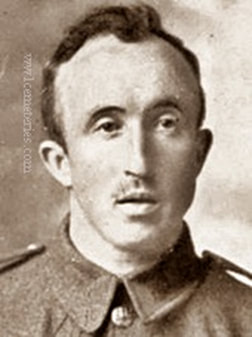
13800 Private
Frederick Gregory Sibson
1st Bn. Leicestershire Regiment, transf. to (582835) 134th Coy. Labour Corps
2nd November 1918.
Plot IV. I. 3.
Frederick Gregory Sibson
1st Bn. Leicestershire Regiment, transf. to (582835) 134th Coy. Labour Corps
2nd November 1918.
Plot IV. I. 3.
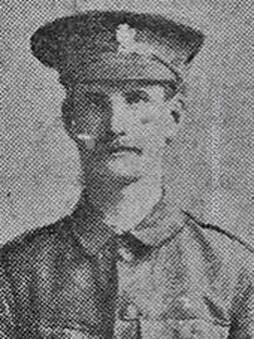
18795 Corporal
Robert Smyth
12th Bn. Royal Irish Rifles
19th October 1918, aged 21.
Plot IV. J. 4.
Son of Robert Smyth, of Woodburn, Carrickfergus, Co. Antrim.
Robert Smyth
12th Bn. Royal Irish Rifles
19th October 1918, aged 21.
Plot IV. J. 4.
Son of Robert Smyth, of Woodburn, Carrickfergus, Co. Antrim.
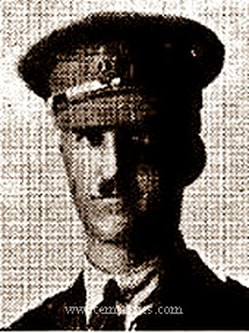
Captain
Charles Cadwaladr Trevor-Roper
14th Bn. Hampshire Regiment
3rd August 1917, aged 33.
Plot I. A. 30.
Husband of Gertrude Alice Trevor Roper, of Plas Teg, Mold, Flintshire. His son Richard Dacre Trevor-Roper, DFC., DFM. fell in the 1939-1945 War.
Charles Cadwaladr Trevor-Roper
14th Bn. Hampshire Regiment
3rd August 1917, aged 33.
Plot I. A. 30.
Husband of Gertrude Alice Trevor Roper, of Plas Teg, Mold, Flintshire. His son Richard Dacre Trevor-Roper, DFC., DFM. fell in the 1939-1945 War.
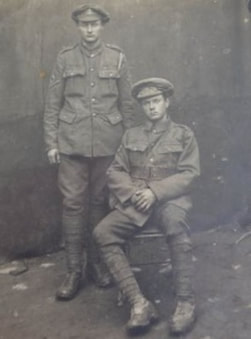
39188 Corporal
George Wood, M. M.
56th Field Ambulance, Royal Army Medical Corps
21st October 1917, aged 21.
Plot I. E. 37.
Son of John K. and Martha Ann Wood, of Hollins Cottages, Grosmont, Yorks.
George (Standing) was killed by shrapnel from a bomb dropped near his Field Ambulance by a Gotha bomber. George won the MM as a result of his actions on 20/21 July 1916 during the Battle of the Somme. He is pictured standing here with his brother, Leonard, a member pf the RND Medical unit.
Submitted by his great nephew Barry Wilson
George Wood, M. M.
56th Field Ambulance, Royal Army Medical Corps
21st October 1917, aged 21.
Plot I. E. 37.
Son of John K. and Martha Ann Wood, of Hollins Cottages, Grosmont, Yorks.
George (Standing) was killed by shrapnel from a bomb dropped near his Field Ambulance by a Gotha bomber. George won the MM as a result of his actions on 20/21 July 1916 during the Battle of the Somme. He is pictured standing here with his brother, Leonard, a member pf the RND Medical unit.
Submitted by his great nephew Barry Wilson
Shot at Dawn
10603 Private, John Seymour, 2nd Bn. Royal Inniskilling Fusiliers, executed for desertion on 24th January 1918, Plot III. F. 10. Already serving under a suspended sentence of death, when he was again convicted & sentenced. (Putkowski, p 235)
10603 Private, John Seymour, 2nd Bn. Royal Inniskilling Fusiliers, executed for desertion on 24th January 1918, Plot III. F. 10. Already serving under a suspended sentence of death, when he was again convicted & sentenced. (Putkowski, p 235)
Images in this gallery © Werner Van Caneghem
The special memorials (the chunky blocks with the inscription beginning: ‘Believed/known to be buried…. ) that are seen here and in countless other cemeteries are known as ‘Duhallow blocks’, after the cemetery where they originated.

